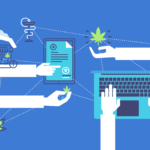As a kid, did you ever trade your entire lunch for your friend’s Pop-Tart? You probably didn’t know it then, but you were bartering. It wasn’t a fair barter but a barter nonetheless.
The barter system dates all the way back to 6000 BC, and it exists still. In fact, 30% of transactions occurring worldwide today are barter. If you think about it, perhaps the first form agreements being made could be seen in bartering.
Speaking of agreements, when was the last time you installed new software, a game or even an app and agreed to terms and conditions without reading them first? I’m guessing, recently.
We sign contracts every day without even realizing it. Did you know that contracts don’t even have to be physically signed to hold up. Ever heard of a verbal agreement or sealing a deal with a handshake? Well, those are just as binding.
In fact, in 1987, Texaco learned this the hard way when the verdict was reached that it had wrongly broken up a deal between Getty Oil and Pennzoil that was sealed by a handshake. That lesson cost Texaco $10 billion back in 1987, and if you’re in the habit of calculating inflation out of curiosity, that would be $21 billion today.
A lot has changed since 1987. Signing agreements can be as easy or as complicated as you want it to be. But before we can truly appreciate today’s revolutionary solutions to completing forms or signing contracts to save you from making a $21 billion mistake ultimately, it would be kind of interesting to go back in time and revisit how the verbal agreement and handshake has evolved through the generations.
The Curious Case of Contracts
The Phoenicians were influenced by the Mesopotamian tribes and adopted bartering and the Babylonians eventually improved the bartering system with the exchange of goods in return for spices, food, tea, and even weapons. Every time a barter took place, and there was an exchange of goods, a contract was made.
The origin of written agreements will make most people uncomfortable, but sadly, the first evidence of a written contract was discovered in a tablet showing the sale of a slave. More evidence of written contracts for the sale of a slave was found from 2300 BC during the Sumerian period.
Perhaps one of the most fascinating pieces of evidence that written contracts existed as far back as 2400 years ago is the recently discovered Egyptian manuscript. It is a little under 8 feet long and details the financial agreement of a couple engaged to be married. Yes, you’re reading it right. We’re talking about a 2400-year old prenuptial agreement.
At some point in history, perhaps in the absence or lack of opportunity to produce a written contract, the handshake became a natural way for two parties to agree on something. It makes sense that the verbal agreement complemented the handshake in sealing deals. While the handshake can be a way to lock in an agreement, most societies use them as greetings.
We know of the existence of handshakes as far back as the 5th century where a depiction of two soldiers can be seen shaking hands is engraved on a funeral stone. However, back then, the handshake was more of a gesture demonstrating peace, proving that they weren’t holding any weapons. Nonetheless, an agreement.
Fast forward to the Ancient Greeks and Romans and contracts have changed dramatically. Not only were signed contracts introduced, but also the classification of contracts based on the nature of the transaction.
Infact, Plato actually had this to say about contracts in “The Laws:
“If a man fails to fulfill an agreed contract – unless he had contracted to do something forbidden by law or decree, or gave his consent under some iniquitous pressure, or was involuntarily prevented from fulfilling his contract because of some unlooked-for accident – an action for such an unfulfilled agreement should be brought in the tribal courts, if the parties have not previously been able to reconcile their differences before arbitrators (their neighbors, that is).”
– Plato, The Laws, Book 11, §23, Contracts.
Sealing the Deal
Times changed. Transactions and people became more complex. Signing agreements moved towards another direction with the introduction of affixing a seal to a contract. There’s abstract reasoning behind how sealing a document with a wax seal by way of imprinting the warm, malleable wax with a ring or seal matrix to leave an impression unique to the owner or organization somehow makes it more valuable. If you received a document and noticed that the seal had been broken, this meant someone had just invaded your privacy. Today, seals are no longer used to close documents or as signatures but to authenticate documents particularly those that are legal in nature.
But despite the progression that agreements and contract signing have gone through, some things are still stuck in the past. If you thought that the 8-foot long Egyptian prenuptial agreement written on papyrus was overkill, let me remind you that legal documents just like that still exist today. We’re talking about a considerable amount of paper used to represent one legal agreement. We’re talking about so much paper that they often need to be kept in a binder and then stored in filing cabinets.
And for companies who had transactions with an international partner, this meant shipping a legal document to be physically signed all the way to another country. Depending on the reliability of shipping service, weather conditions, customs procedures, those documents could take days to months to reach the hands of the person whose signature sealed a deal. This meant that it could take a deal days to months before it became legally binding even if an agreement had already been made over a long-distance call.
Companies soon began to adopt the practice of emailing these documents as PDFs, and the receiving party would affix their signature on them by inserting an image of their scanned signature.
Electronic & Digital Signatures
There have been innovative advancements that will help you with affixing your signature to a PDF document and save you the hassle of having to buy a digital pen tablet like the ones that digital artists use. Signority, allows you to sign your signature with just your finger via your smartphone or tablet. You can even upload an image of your signature with the click of a button.
There’s also been some much-needed progress in the way businesses share documents for signing. Perhaps it was the annoying stack of legal documents or that companies now have both a social and legal responsibility to go green, but soon, paper contracts may be a thing of the past with the introduction of eSignatures.
In 2002, the Electronic Signatures in Global and National Commerce Act (ESIGN Act) was signed into United States law that officially made the e-signature acceptable and binding. The ESIGN Act states that a contract or signature “may not be denied legal effect, validity, or enforceability solely because it is in electronic form.”
For so many companies, it was the electronic signature that was their biggest blocker from going completely digital in their exchange of documents electronically. But with this law being passed and being accepted by the majority of international markets, companies are now able to progress to greener business practices and adopt a paperless platform — saving them tons of money in the long run.
The Future of Document Signing
I doubt that when ancient man first exchanged a human skull for tea and spices, they imagined a day would come when anything but blood sealed agreements would be the norm. Centuries have passed, and just a decade ago, our handwritten signatures were what signed deals and cemented contracts. Today, signatures can be affixed digitally, and contracts can be legally binding in a matter of clicks.
But with biometric technology that already unlocks our smartphones, laptops, doors, and cars; is it impossible for that day to come when we can “sign” a document by simply placing our hand or palm on the surface of a tablet or touch screen? How about “affixing your signature” with the scan of your retina?
If you think about it, it doesn’t really seem impossible or that far off — especially, since implantable technology is already predicted to be available to consumers in the next 5 years.
We’re talking about internables or implantables that are being developed to do everything from unlocking doors, control objects, and automatically sets your thermostat to your desired temperature when your home senses you are a few meters away. These ingestible pills or chips will be secured under your skin, and yes, they will even be used to authenticate transactions.
With the rapid technological advancements that we are currently experiencing, it’s hard not to believe that a complete digital future is just around the corner.
Looking to go Digital? Sign-up now and get a 14-day free trial to a Signority eSignature Plan.








